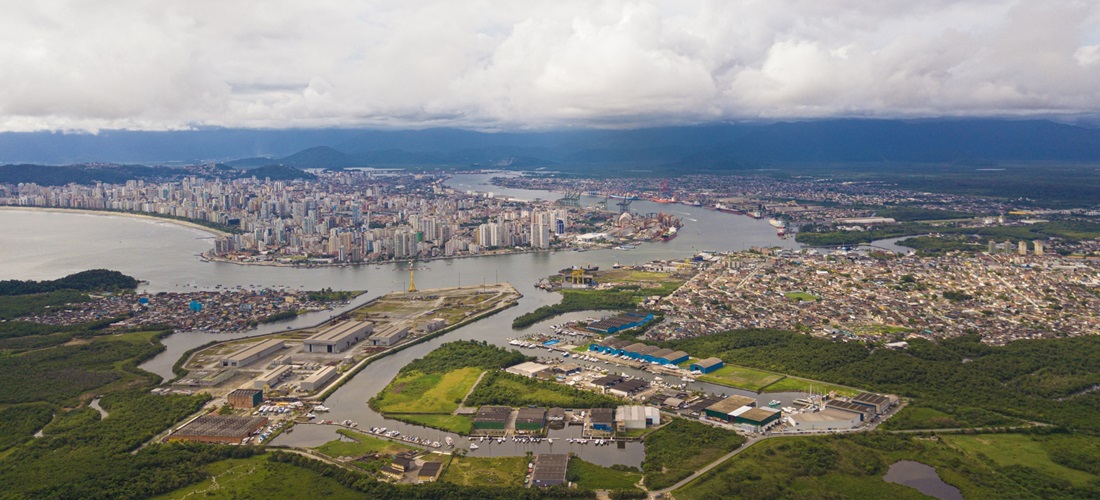
Regulatory agency oversees decontamination efforts in Port of Santos areas
Sep, 09, 2024 Posted by Gabriel MalheirosWeek 202427
The São Paulo State Environmental Company (Cetesb) is closely monitoring three contaminated areas within the Organized Port overseen by the Santos Port Authority (APS), which is currently reviewing the environmental studies related to these locations.
“Contaminated area surveillance is carried out in sequential phases, starting with a preliminary assessment and ending with the implementation of an intervention plan. Besides, it is conducted independently, meaning that each area may be at a different contamination control stage, ” Cetesb stated.
Alemoa
Two spots in Alemoa (Warehouse A and the annex of Warehouse C) have been identified with groundwater contamination by metals and halogenated aromatic solvents (flammable or highly flammable liquids). These sites are currently in the final monitoring stage, which means that efforts are underway to ensure that the concentration of contaminants in the samples is below the targets set in the intervention plan. Monitoring reports were submitted in July 2022 and are under review.
Macuco
In the Macuco neighborhood, the former railway depot on Avenida Perimetral showed soil and groundwater contamination by creosote, a complex mixture of organic compounds, including polycyclic aromatic hydrocarbons (produced by incomplete combustion), phenols, and heterocyclic hydrocarbons.
Remediation was conducted through soil and waste excavation and removal, followed by road construction. The area has been recommended for entering the final monitoring stage, and reports from three monitoring campaigns have been submitted and are under evaluation.
Outeirinhos
The former fuel station of Codesp (Outeirinhos), located on Francisco Ribeiro Street, was identified as contaminated in 2005. Remediation efforts began in 2006, and various interventions have taken place to address the contamination over the years. In 2021, the final monitoring stage commenced as part of the Contaminated Area Management process.
Once the submitted reports are reviewed, a Declaration of Rehabilitation will be issued, provided that contaminant concentrations are confirmed to be below the maximum acceptable limits, meaning the contamination no longer poses a risk to human health.
How It Works
Once contamination is confirmed, Cetesb requires the firm responsible for the site to conduct contaminated area studies and implement intervention measures for proper contamination control. “One possible intervention measure is site remediation. Risks vary from one location to another, depending on the characteristics of the contaminants involved, site occupancy, impacted media, and other variables considered in the risk assessment,” Cetesb said in a statement.
APS Responsible for Oversight
The Santos Port Authority is responsible for overseeing and controlling environmental liabilities in public areas of the Port of Santos, while terminals are responsible for managing any liabilities within their leased areas as part of their licensing processes with the relevant environmental agency.
“In this context, it is important to note that APS monitors all of these actions (whether under its responsibility or that of the terminals) through the Environmental Liabilities Regularization Program,” the Port Authority stated.
Additionally, whenever a lease contract ends, an environmental investigation is required to assess the risk of any new ecological liabilities potentially arising from operations on the site over time. “If contaminants are detected, the responsible party must take all necessary measures to control the liability (remediation, monitoring, etc.),” the statement detailed.
According to APS, monitoring efforts under the Environmental Liabilities Regularization Program show improvements in the environmental conditions of the public areas assessed, indicating that they are suitable for future use. “Over the past four years, there has been no demand for environmental remediation under the direct responsibility of the Port Authority.”
APS also highlighted the continuation of routine environmental inspections, joint environmental enforcement actions with other authorities, emergency response operations, and waste management as key elements in preventing pollution in port areas.
Unidentified Sites Pose Risks
According to the Santos Port Authority (APS), the primary risks associated with environmental liabilities are linked to unidentified contaminated areas. These risks include groundwater contamination, human exposure to contaminants, and potential impacts on nearby ecosystems.
“APS is making efforts to expand the diagnosis of areas under its oversight to identify potentially contaminated sites. A Terms of Reference for providing preliminary assessment studies for 11 regions of the Organized Port of Santos has been issued,” the agency explained.
According to APS, the preliminary assessment will involve a series of inspections and documentary and historical reexaminations to identify potential contamination sources (current or past) and develop a Confirmatory Investigation Plan.
“Known contaminated areas have undergone or are undergoing environmental remediation to mitigate associated environmental impacts and to monitor improvements in the environmental quality of these sites,” APS stated.
Source: A Tribuna
Click here to access the original text: https://www.atribuna.com.br/noticias/portomar/cetesb-faz-analise-de-estudos-de-areas-contaminadas-no-cais-de-santos-1.433305
-
Ports and Terminals
Jun, 24, 2021
0
Imetame Logística starts works at the Port of Aracruz
-
Meat
Jun, 21, 2022
0
Canada to expand the range of Brazilian meatpackers allowed to export pork
-
Ports and Terminals
Sep, 30, 2024
0
Ningbo-Zhoushan Port to develop new 2 million TEU terminal
-
Other Cargo
May, 03, 2021
0
Andali expands activity in Brazilian fertilizer market


